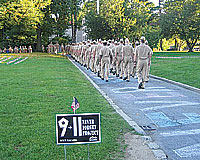NCAA News Archive - 2006
« back to 2006 | Back to NCAA News Archive Index
Few schools felt the impact of 9/11 like the U.S. Merchant Marine Academy
|
The NCAA News
Editor’s note: The NCAA News published a story in the September 11 issue regarding how the events of 9/11 affected service academies; however, the article did not reference the U.S. Merchant Marine Academy.
The U.S. Merchant Marine Academy is situated on the waterfront of the Long Island Sound and overlooks New York City. Located just seven miles from the city, many Merchant Marine students, faculty and staff watched from academy grounds on September 11, 2001, as a second plane slammed into the south tower of the World Trade Center while smoke and fire poured from the other.
In the days afterward, as was the case at other service academies, security on the campus was tightened. Visitors were limited, vehicles were searched and fans were screened before entering sporting events. Five years later, some of those measures have been relaxed. What hasn’t faded, though, is the memory of the key roles the Merchant Marine personnel and student body — 65 percent of which is composed of varsity athletes — played in the hours and days just after terrorist attacks rocked the nation.
On the morning of September 11, Merchant Marine Director of Athletics Susan Petersen Lubow was at home, just five days into maternity leave after giving birth to her first child, a daughter. After initially being alerted by her husband and then watching the tragedy unfold on television, Lubow received a call that emergency personnel wanted to use Merchant Marine’s athletics fields to airvac victims to hospitals because they anticipated local facilities would be overwhelmed.
"Of course, there were no victims to send to hospitals," recalled Lubow. "Then we got the call that they wanted us to set up our gymnasium as a potential morgue to take body bags. We did that, but there were no bodies."
Meanwhile, all off-duty firefighters, police and other emergency personnel also were alerted to come back to the city on the morning of 9/11. Eric Wallischeck, then director of waterfront activities at Merchant Marine and currently an assistant superintendent, said a faculty member who also was a firefighter called about the school using one of its many boats to ferry him and a few colleagues to the World Trade Center site.
Initially, the academy sent two boats and a half dozen people. By day’s end, the numbers had swelled to nine boats and more than 50 people, including a number of midshipmen who were trained EMTs.
"For the first day, they did everything from evacuating people from Manhattan to Brooklyn to providing basic medical services such as washing out eyes, and treating twisted limbs, cuts and bruises," said Wallischeck, who organized the makeshift fleet. "The boats got back really late that night — 10 or 11 p.m. It was a pretty harrowing scene to see them coming back covered with dust. Obviously they’d been through quite a lot and experienced a lot of pain."
Working mostly with the fire department, Merchant Marine ultimately dedicated four boats to the first nine days of the recovery effort. Because much of the fire-main infrastructure in Lower Manhattan had been destroyed when the towers collapsed, the fire department was using its fireboats to pump water from the Hudson River to temporary mains near the site. Said Wallischeck,"What we were able to provide was a shuttle service for firefighters from their facilities in Brooklyn to various locations where they had their boats. We helped move personnel, fuel and supplies that they needed to man and operate their vessels."
Later, Merchant Marine vessels were used to transport supplies from Jersey City to the main staging area at the World Financial Center Yacht Harbor, located about 500 yards from Ground Zero. Wallischeck said as many as 182 Merchant Marine personnel, including 105 midshipmen, contributed their time and skills in the days just after the terrorist attacks. He called the opportunity to be involved in the 9/11 recovery effort one of the things of which he’s most proud.
"At that time, there were 280 million Americans who wanted to help and not everyone had a chance to do that," he said. "This little gesture was just a way of getting some of our staff and more than 100 midshipmen to lend a hand when it was necessary."
Given the way the world has changed since 9/11, the need for that helping hand has become constant. For Merchant Marine midshipmen, that may mean being put in harm’s way before finishing their four-year course of study. One of the most notable distinctions between Merchant Marine and other service academies is the requirement that each midshipman serve one full year at sea — four months during the sophomore year and eight months as a junior. In peace time, the ships move cargo; in times of war, the vessels are called upon to move troops and ammunition.
"Our midshipmen are on these ships for their sea training and they go wherever the ship goes," said Lubow. Consequently, Merchant Marine is the only academy to carry a battle standard with streamers representing every conflict since World War II. "We’re the only one to carry the battle standard because we are the only one who puts midshipmen in harm’s way. We’re proud of that distinction."
© 2010 The National Collegiate Athletic Association
Terms and Conditions | Privacy Policy

